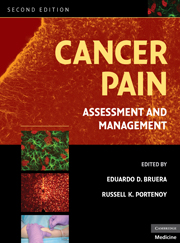Book contents
- Frontmatter
- Contents
- Contributors
- Preface
- SECTION I MECHANISMS AND EPIDEMIOLOGY
- SECTION II EPIDEMIOLOGY AND SYNDROMES
- SECTION III ASSESSMENT
- 5 The assessment of cancer pain: measurement strategy
- 6 Multidimensional assessment: pain and palliative care
- 7 Evaluating pain for children with cancer
- 8 Pain syndromes in cancer survivors
- SECTION IV PHARMACOLOGICAL TREATMENT
- SECTION V OTHER INTERVENTIONAL STRATEGIES
- SECTION VI REHABILITATION AND PSYCHOLOGICAL INTERVENTIONS
- SECTION VII THE ROLE OF ANTINEOPLASTIC THERAPIES IN PAIN CONTROL
- SECTION VIII PAIN IN SPECIAL POPULATIONS
- SECTION IX DIFFICULT PAIN PROBLEMS
- SECTION X SYSTEMS OF CARE
- Index
- Plate section
- References
5 - The assessment of cancer pain: measurement strategy
from SECTION III - ASSESSMENT
Published online by Cambridge University Press: 06 July 2010
- Frontmatter
- Contents
- Contributors
- Preface
- SECTION I MECHANISMS AND EPIDEMIOLOGY
- SECTION II EPIDEMIOLOGY AND SYNDROMES
- SECTION III ASSESSMENT
- 5 The assessment of cancer pain: measurement strategy
- 6 Multidimensional assessment: pain and palliative care
- 7 Evaluating pain for children with cancer
- 8 Pain syndromes in cancer survivors
- SECTION IV PHARMACOLOGICAL TREATMENT
- SECTION V OTHER INTERVENTIONAL STRATEGIES
- SECTION VI REHABILITATION AND PSYCHOLOGICAL INTERVENTIONS
- SECTION VII THE ROLE OF ANTINEOPLASTIC THERAPIES IN PAIN CONTROL
- SECTION VIII PAIN IN SPECIAL POPULATIONS
- SECTION IX DIFFICULT PAIN PROBLEMS
- SECTION X SYSTEMS OF CARE
- Index
- Plate section
- References
Summary
Regular pain assessment and pain management should have the highest priority in the routine care of the patient with cancer. Between 60% and 80% of patients with advanced cancer will need pain treatment. Pain is also a problem for many patients early and intermittently during the course of their disease. In addition, cancer survivors who are cured of their cancer may have persistent chronic pain as a result of the disease or its treatment.
When pain is present, the quality of life (QOL) of patients and their family members is adversely affected. However, the majority of patients with cancer-related pain can obtain pain relief if the pain is adequately assessed and appropriate treatment is provided. Numerous guidelines for the management of cancer pain have been endorsed by governmental organizations, professional associations, and the World Health Organization (WHO). Research studies evaluating the WHO guidelines (1986, 1996) for cancer pain relief indicate that 70%–90% of patients obtain good pain relief when this protocol for oral analgesic medications is followed. Other pain management therapies can provide pain control when oral analgesics are not effective.
In spite of the availability of effective pain treatments, multiple studies document undertreatment of pain. A study completed by the Eastern Cooperative Oncology Group (ECOG) surveyed more than 1300 outpatients with recurrent or metastatic cancer. Sixty-seven percent of the patients had pain or were being treated for pain with daily analgesics.
- Type
- Chapter
- Information
- Cancer PainAssessment and Management, pp. 89 - 104Publisher: Cambridge University PressPrint publication year: 2009
References
- 1
- Cited by



